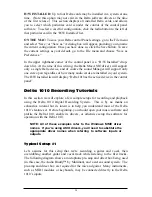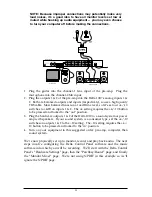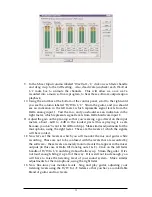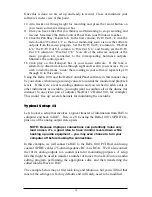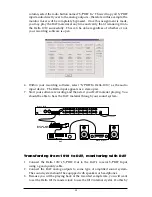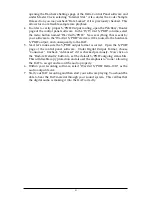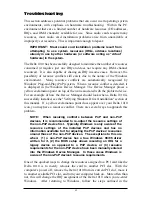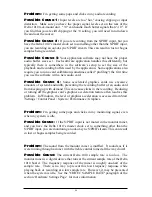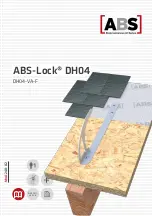
Troubleshooting
This section addresses potential problems that can occur in all operating system
environments, with emphasis on hardware troubleshooting. Within the PC
environment there are a limited number of hardware resources (I/O addresses,
IRQs, and DMA channels) available for use. Since audio cards require many
resources, most audio card installation problems arise from unavailable or
improperly set resources. This is important enough to repeat:
IMPORTANT: Most sound card installation problems result from
attempting to use system resources (IRQs, address locations)
already in use by other hardware (or software acting as “virtual”
hardware) in the system.
The Delta 1010 has been carefully designed to minimize the number of resources
consumed (it requires just one IRQ and does not require any DMA channel
resources). It is also capable of sharing an IRQ in some cases. However, the
possibility of resource conflicts still exists due to the nature of the Windows
environment. Many resource conflicts are automatically recognized by
Windows’ Plug-and-Play (PnP) system. When a resource conflict is detected, it
is displayed in the Windows Device Manager. The Device Manager places a
yellow exclamation point on top of the icon associated with the problem device.
For an example of how the Device Manager should look when a Delta 1010 is
successfully installed, see the "Verifying Windows Driver Installation" section of
this manual. If a yellow exclamation point does appear over your Delta 1010
icon, you may have a resource conflict. There are several ways to approach this
problem.
NOTE: When resolving conflicts between PnP and non-PnP
devices, it is recommended to re-adjust the resource settings of
the non-PnP device first. Typically, Windows is only aware of the
resource settings of the installed PnP devices and has no
information available to it for adjusting the PnP devices’ resources
around those of the non-PnP devices. The exceptions to this are
when: (1) a non-PnP device has a true Windows 98/95 driver
written for it, (2) the BIOS setup allows reserving an IRQ for a
legacy device as opposed to a PnP device, or (3) resource
requirements for the non-PnP device have been manually entered
into the Windows Device Manager. In these cases Windows is
aware of the non-PnP device’s resource requirements.
One of the quickest ways to change the resources assigned to a PCI card like the
Delta 1010 is to merely relocate the card to another PCI slot. With the
computer’s power off, remove the Delta 1010 from its current PCI slot, move it
to another available PCI slot, and turn your computer back on. More often than
not, this will change the IRQ assignment of the Delta 1010 when you re-enter
Windows. After returning to Windows, follow the steps outlined in the
42
Summary of Contents for Delta 1010
Page 51: ...51 Notes...
Page 52: ...52 D1010 111700...

